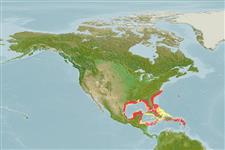Common names from other countries
Environment: milieu / climate zone / depth range / distribution range
पारिस्थितिकी
समुद्री प्रवाल-भित्ति संयुक्त; गहराई सीमा 0 - 100 m (Ref. 108738), usually 0 - 18 m (Ref. 7251). Subtropical; 37°N - 15°N
Western Atlantic: southern Chesapeake Bay south along the U.S., Bahamas, throughout the Gulf of Mexico except northwestern Cuba; in the Caribbean from southern Jamaica, and along Central and South America from Mexico to the Honduran Bay Islands, and Colombia to Brazil (Santa Catarina).
आकार / वज़न / Age
Maturity: Lm ? range ? - ? cm
Max length : 20.0 cm TL पुल्लिंग / अलिंग; (Ref. 7251)
Inhabits hard sand bottom from water's edge to 18 m depth, occasionally to 90 m.
Life cycle and mating behavior
परिपक्व अवधि | पुनरुत्पत्ति | मछलीऔ का अंडे देना | अंडे | Fecundity | लार्वा
Distinct pairing (Ref. 205). Oviparous (Ref. 101737). Females produce numerous eggs in multiple spawnings during a prolonged spawning period (Ref. 101737).
Robins, C.R. and G.C. Ray, 1986. A field guide to Atlantic coast fishes of North America. Houghton Mifflin Company, Boston, U.S.A. 354 p. (Ref. 7251)
IUCN Red List Status (Ref. 130435)
CITES (Ref. 128078)
Not Evaluated
Threat to humans
Harmless
Human uses
अधिक जानकारी
संदर्भजलीयकृषिजलीयकृषि रूपरेखाखींचआनुवंशिकीElectrophoresesहैरेटिबिलटीबीमारीप्रक्रमणMass conversion
साधन
Special reports
Download XML
इंटरनेट स्रोत
Estimates based on models
Preferred temperature (Ref.
115969): 23.4 - 28, mean 26.5 (based on 426 cells).
Phylogenetic diversity index (Ref.
82804): PD
50 = 0.5000 [Uniqueness, from 0.5 = low to 2.0 = high].
Bayesian length-weight: a=0.00661 (0.00428 - 0.01019), b=3.13 (3.01 - 3.25), in cm Total Length, based on LWR estimates for this species & Genus-body shape (Ref.
93245).
Trophic level (Ref.
69278): 3.5 ±0.5 se; based on size and trophs of closest relatives
लौटाव (Ref.
120179): ऊंचा, न्यूनतम जनसंख्या दुगनी समय अवलागत 15 महीने। (Preliminary K or Fecundity.).
Fishing Vulnerability (Ref.
59153): Low vulnerability (10 of 100).
